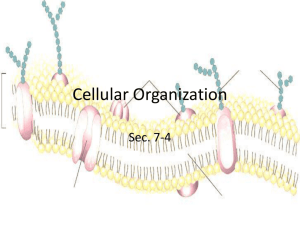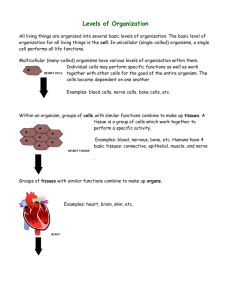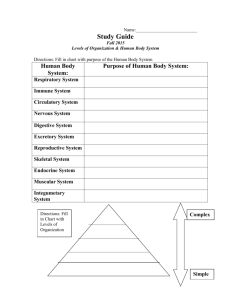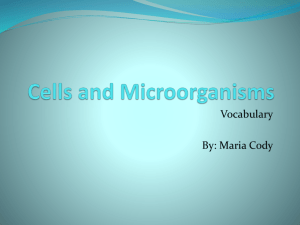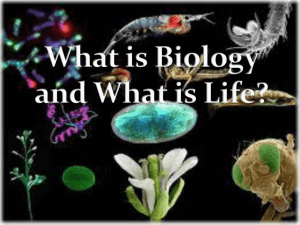Cells
advertisement
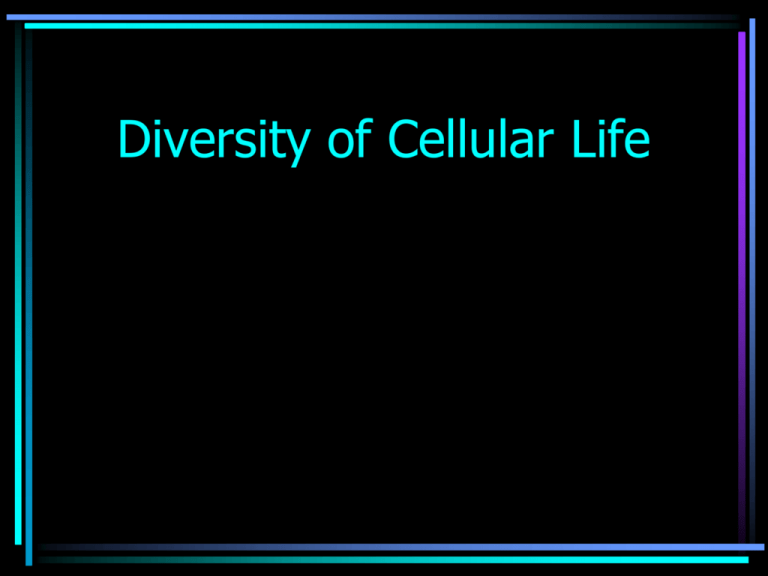
Diversity of Cellular Life Cells • Are the simplest form of life • Chemical elements organized into cells become living matter. • All organisms are made-up of cells • All the substances of an organism are the products of its cells Life is Cellular – – Some things are only one cell (unicellular) Some have many cells (multicellular) Unicellular or Multicellular • SINGLE CELL ORGANISM • MULTI-CELL ORGANISM Cells are small for 2 Reasons Reason 1: Limited in size by the RATIO between their Outer Surface Area and Their Volume. A small cell has more SURFACE AREA than a large cell for a GIVEN VOLUME OF CYTOPLASM. Unicellular Organisms may be Prokaryotic Eukaryotic Remember? What does the Eukaryotic Cell have that Prokaryotic Cells does not? No nucleus No organelles Has a nucleus Has organelles Colonial Organisms Video: • A colony of single-celled organisms is a colonial organism. It's likely that early colonial organisms were the first evolutionary step from single celled life to multicellular species. Synura (above) and rotifer egg. Synura: Three individual colonies. Ref: synura01. Three Scenedesmus. Ref: scened00 Volvox releasing daughter colonies. Ref: volvox01 Colonial Organisms • The difference between a multicellular organism and a colonial organism is that individual cells from a colony can, if separated, survive on their own, while cells from a multicellular life form (e.g., liver cells) cannot. Filamentous Algae Colonial Organisms • In a multicellular organism the cells have become specialized and taken on specific jobs to help out the whole organism • In a colonial organism, there is little difference between cells. Volvox carteri, a colonial freshwater alga. The small dots are regular cells and the large ones are asexual reproductive cells Cell Differentiation • Cell differentiation- When cells take on a different shape, size, and chemistry, suitable for a certain function during development. • Cells vary in size, shape, and internal components • The variety of cell shapes include round, flat, long, rectangle, etc. • Some cells have different extensions from the cell membrane Cell Specialization • cell specialization- The characteristic of having separate roles for each type of cell in a multicellular organism; the cells is specifically designed for a certain function; it has a certain purpose or job. • The size and shape of a cell is related to its function Division of Labor • division of labor- A more efficient way of getting jobs done in a multicellular organism because the different tasks are dispersed to different cells, each of which is specialized to do that job. • The organelles that make up a certain cell are also determined by the specific functions carried out by the cell Levels of Organization • levels of organization- A system of hierarchy in which a group of things are arranged in order of rank, complexity, or size. Each group is made up of smaller parts and/or are a part of a larger group. (example- cells form tissues, which form organs, etc.) Levels of Organization • • • • Cell Tissue Organ Organ system Cells Many different types of cells are formed during embryonic development. Cells Continued • Cells occur in many different shapes and sizes so they can perform many different functions. Tissue Many different cells work together to form a tissue. Cartilage Fat Muscle Skin Nerves Bone Organ Many tissues working together form an organ Organ System Each organ system is made up of several different organs that work together and enable the system to do its job. Eleven Organ Systems • • • • • • Circulatory Digestive Endocrine Excretory Integumentary Lymphatic • • • • • Muscular Nervous Reproductive Respiratory Skeletal Review of Organization 1. Cells – have a special job to do (i.e. cell from intestine) Review of Organization 2. Tissues – a group of similar cells that work together to carry out a special job (i.e. group of lining cells in intestine) Review of Organization 3. Organ – a group of tissues that work together to do a job (i.e. small intestine) Review of Organization 4. Organ system – a group of organs that work together to do a certain job (i.e. digestive system) Review of Organization 5. Organism – all organ systems working together (i.e. digestive, respiratory, circulatory, etc.) Review of Organization Review of Organization • Some organisms are made up of only one cell but they have all the features of living things – The parts of their cell still work together • Other organisms have organs and organ systems like humans – Systems work together to keep us alive
